The Ups and Downs of the Europa’s Nose
Last week I wrote about finishing the rear suspension work on the Armada by installing taller, stiffer Moog springs to go with the Bilstein shocks as part of the delete of the pneumatic self-leveling rear end. Today I’m going to address the yang to go with the Armada’s yin—lowering the front suspension of my 1974 Lotus Europa Twin Cam Special.
“Wait,” many of you are probably saying. “Haven’t you written about this before?” Yes. Multiple times. When I bought the long-dead car in 2013, it was sitting on the original springs and blown Armstong shocks. When I finally finished rebuilding the engine, woke the car from its nearly 40-year slumber, and got it running in 2019, I replaced the calipers, rotors, pads, ball joints, tie rods, and trunions, and drove it that way for a few months, but this wasn’t like reviving a Ford Model A milk truck that you only want to limp to Cars and Coffee twice a year—you want it to handle like a Lotus. The Armstrong shocks went out of production decades ago, so you need to choose between a few brands of shocks with adjustable firmness, height, or both. Plus, as I wrote about here, U.S.-spec Europa Twin Cams like mine had the nose artificially raised to satisfy Federal headlight spec requirements, and thus look a bit like a skiff on plane. Because of that, anyone like me going through a suspension refresh lowers the nose as part of it.


If you’ve learned anything from reading these pieces, it’s that I’m not a wealthy man, and in order to own, maintain, and drive 13 older vehicles, I am relentless about cost-containment and save money wherever I can. Replacing the entire suspension—shocks, springs, wishbones, everything—with new adjustable parts would’ve set me back $2500, and it seemed like massive overkill on a ratty, heavily-patina’d Europa. Staying focused on just the front shocks and springs, a set of new Spax height and firmness-adjustable shocks and matching lowering springs would’ve been about $800. Instead, for $225 I bought a set of four (front and rear) used Spax shocks on eBay that were what would’ve been put on the car in the early ’80s (firmness-adjustable but not height-adjustable), and bought a set of QA1 front lowering springs that had the height and spring rate widely recommended on Europa forums on Amazon for $80 for the pair. I eventually also bought the recommended lowering springs for the rear of the car. The lowered car, especially the nose, looked great—the car looked like it was ready to jump in at Le Mans (which, not coincidentally, was essentially the design goal of the Europa when it was first introduced—a mid-engined fiberglass-body-on-stressed-member-frame car for the masses).

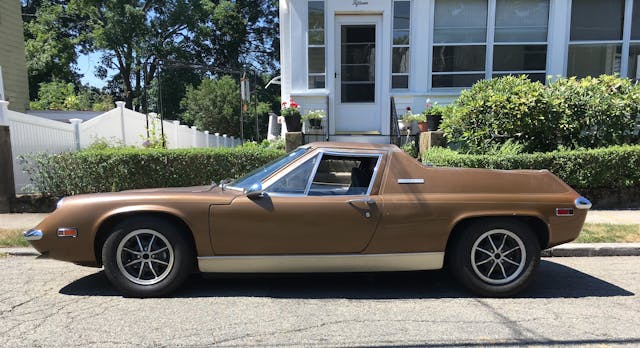
I found that lowering the car caused all four wheels to camber outward at the bottom, so I slotted the front wishbones and home-built adjustable links for the rear to compensate.

After dialing in toe and camber, the car handled well, but regardless of how I adjusted the stiffness of the front shocks, the front end always felt like it was about to break off if I hit any pavement irregularity bigger than a flattened soda can.
So this spring, I took a step backward and undid everything. Well, not everything—the blown Armstrong shocks had long ago been thrown in the recycle bin—but I yanked out all four shocks and springs, removed the front and rear lowering springs, mounted the original springs on the 40-year-old adjustable Spax shocks, and undid my adjustable camber mods. Many reader’s comments to the piece linked to above were of the form “Kudos, to you, the designers usually knew what they were doing,” but this wasn’t a philosophical exercise in “stock is always better.” The banging indicated that something was wrong, and it stood to reason that something was done by me, so I wanted to undo it.
I reported that the car’s tolerance for pavement irregularity was much improved, but that turned out to be premature—when I drove it more, I discovered that when it encountered a pothole, frost heave, or step-change in road paving, there was still a clunk so severe that I wondered if the weld attaching the “hammerhead” section of the Europa’s T-on-Y-shaped frame was cracked.
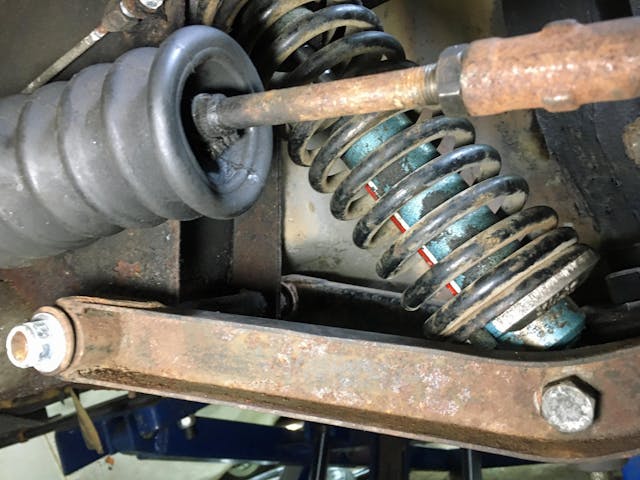

So early this summer I put the Lotus back up on the mid-rise lift and methodically dissected the front end. I roped my two adult children who live with us into bouncing the car while I laid beneath it, laying my hands and a mechanic’s stethoscope on every component. It made a small repetitive noise when bounced—not the obvious thunk/clunk like what I heard while driving, but something that shouldn’t be there. Visually I could see that it wasn’t due to coil-binding, and it didn’t seem to be the springs banging in the perches, but was very difficult to isolate. At first I swore it was coming from the wheel bearings. I tightened them, but no change. Then I discovered play in a long wishbone-securing bolt that went through a tubular sleeve. It shouldn’t have made a difference when the bolt was tightened, but I shimmed it with a cut-up seltzer can anyway. No change. It was maddening.
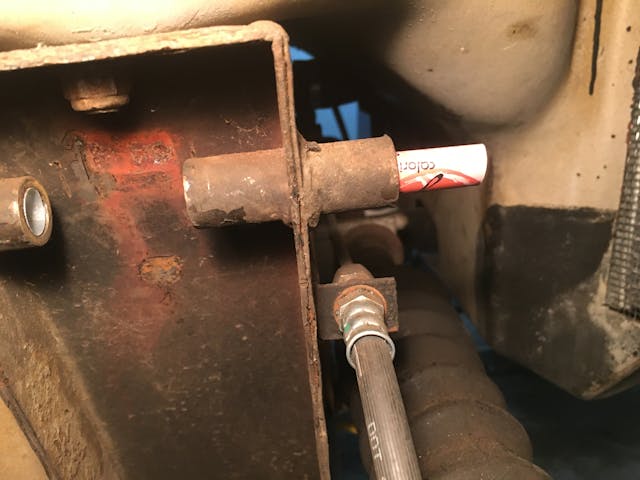
Frustrated, I entered into a scheme of systematically removing front-end components. The sway bar came off first. Then I supported the ends of the lower wishbones on jack stands and removed the wheels, rotors, and bearings, thereby letting me bounce the car on the suspension while taking these components out of the picture. I went a step further by removing the trunions. Next I eliminated the steering as a cause by undoing the tie rods and removing the steering knuckles. It turned out that there was a bit of play in both the steering column and the rack, but the primary noise was still there.

Eventually, all that was left were the shocks, springs, and wishbones. The wishbones and their rubber bushings were original to the car, so they were certainly not beyond suspicion. I’d left them in place five years ago because the bushings were hard but not degraded and wouldn’t succumb to being pressed out without risking bending the feather-light no-longer-available wishbones. I found that the noise manifested itself at the top of the load on the shocks—that is, if I bounced the car a few times to create the noise, it occurred at a certain suspension height, but if then lifted up the nose and allowed the shocks to extend, the noise occurred higher up. This seemed to clear the wishbones and implicate the shocks as the source of the noise.
I was willing to pay the $600 cost for a new set of Spax fully-adjustable shocks, but I needed to be virtually certain they’d fix the problem, because if they didn’t, I was going to be pissed. I found that if I ordered them from a Lotus house in England I could save about $70, but the main supplier of vintage Lotus parts on the east coast is RD Enterprises in Pennsylvania, they’re an essential part of the vintage Lotus community, and I do enough price-shopping and click-and-buying of normal-wear-and-tear parts (certain items are shared with Triumphs) from other vendors that I felt it was important to give RD this sale.
While waiting on shipment, I pulled the suspect Spax shocks with the original springs on them out of the car. I thought about pulling the springs off them so I could directly extend and compress the shocks and feel if they were bad, but I decided against it, as it would just make work for myself, and didn’t replicate what actually happens under load.
A few days later, the box containing the brand-new school bus-yellow firmness-and-height-adjustable Spax shocks arrived. I broke out my Rube Goldberg homemade spring compressor one more time and mounted the QA1 lowering springs on the shocks, which was way easier than mounting the original springs was because the shorter springs require much less compression. I reassembled the front end, which I’ve gotten very good at because this was the third time I’ve done it.
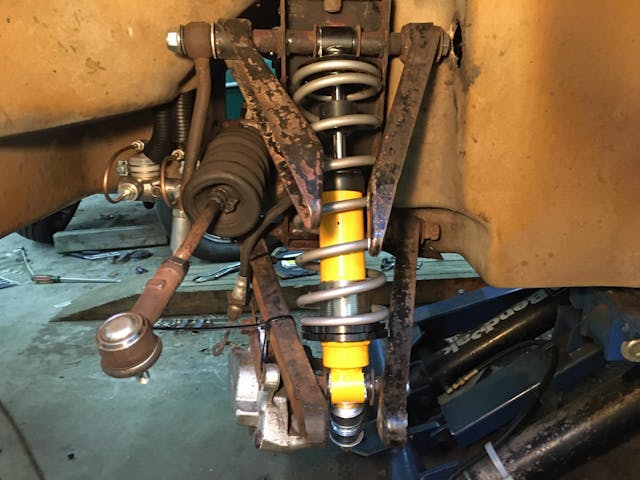
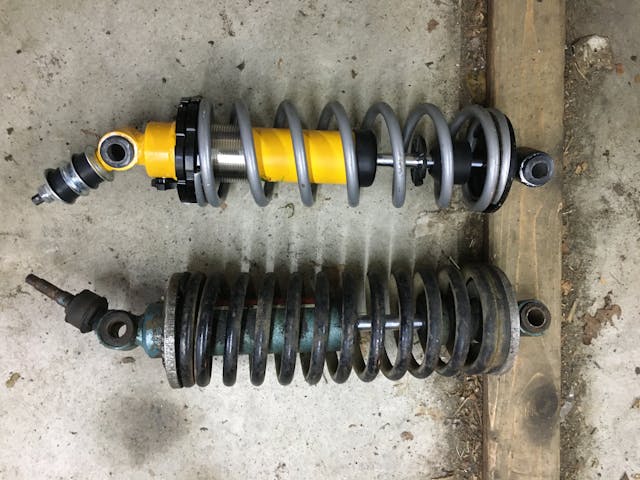
And then life in all its glorious automotive and non-automotive forms interfered. The Lotus sat on my mid-rise lift all summer while I futzed with the Armada’s flaky air conditioning, visited my middle son in Santa Fe, and bought, regretted, and embraced the FrankenThirty. I didn’t really mind. Most of my vintage cars have air conditioning, but the Lotus is not among them, and there’s a slightly acidic mousy tang to the car’s scent that doesn’t play well with summer weather (hot, humid, and mousy is rarely a good combination), so waiting ‘till the crisp breath of September to drive it was fine. It actually was the need to swap wheels and tires on the FrankenThirty that got the Lotus kicked off the lift, out of the garage, and into the driveway, and my realizing that I hadn’t driven it since the new shocks went in was almost an afterthought.
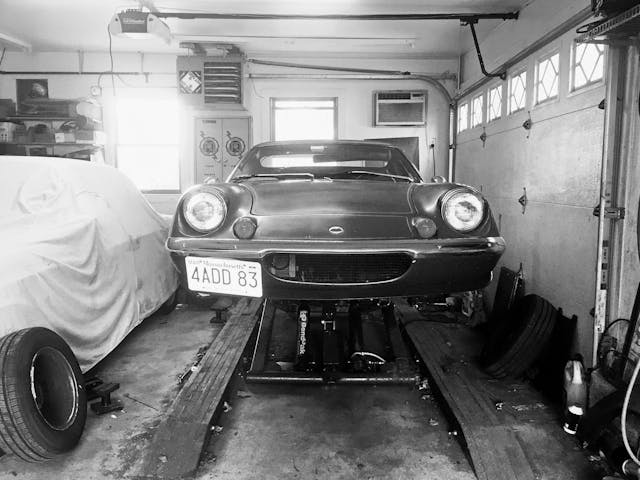
Okay then. Around the block it went. There were a few groans as things settled, but nothing egregious. I then headed for “the torture track”—a particularly badly-paved stretch of road a few streets over. Thunk-and-clunk-wise, things seemed much better, but the steering seemed to get looser by the minute, and the handling felt odd. I put the car back in the garage and found that I hadn’t sufficiently tightened down a collar nut after adjusting the steering column, and had forgotten to slide the upper ball joint forward in the slotted holes I’d made in the wishbones to account for the camber change from lowering the car.
I made those changes, went around the block again, then drove the car about 20 miles on the twisty roads in the affluent leafy suburbs west of Boston where driving the Europa at 42 mph in a 35 zone is so much fun that you feel like you should be arrested.
And?
Oh my lord. I nailed it. The front-end banging is completely gone. I don’t need to cringe and tighten my abs and sphincter every time I approach uneven terrain and slow to a crawl over railroad tracks. It feels absolutely amazing. In retrospect, yeah, I should’ve just paid the money and done this five years ago. Whether the eBay Spax shocks are actively broken, or somehow mismatched to the springs, or were for a Europa S2 but not a Twin Cam, I don’t know. And I don’t care.
There’s still tweaking to be done—I haven’t realigned it, and the 75-mph highway stability of the car isn’t quite what I’d like. Plus, the rear of the car is still sitting on the 40-year-old Spax shocks and original springs. But the novelty of the car no longer feeling like someone dropped an apple crate full of tools over every bump is going to take a long time to wear off.
And yes, the car now looks level, and that nose looks properly settled, with Lolita showing just a hint of ankle. She is, after all, a lady.

***
Rob’s latest book, The Best Of The Hack Mechanic™: 35 years of hacks, kluges, and assorted automotive mayhem, is available on Amazon here. His other seven books are available here on Amazon, or you can order personally inscribed copies from Rob’s website, www.robsiegel.com.



After all your work…
The long front springs that came on the “Federal” Europa Twin Cam were…
1) Unique to the Federal models, and raised the nose to meet Federal Regulations for bumper height, and for headlight height.
2) Existed no where else within Lotus. Not in the factory’s parts inventory, and not in the Workshop or Parts Manuals. “IF” you called a Lotus parts vendor or LCU (Lotus Cars USA) and told them you needed/ wanted front springs for your Sept 1971 onward Europa, you would receive the “Book Spec” springs… ie, Euro Spec. “Federal” spec did not exist, other than to get the car into the USA, thru customs, and off the dock.
In short, all you had to do was install a pair of “Spec” springs (Euro Spec), and your car’s ride height would have been where it needed to be. The adjustable ride height shocks were then un-necessary… well, in theory. Everything man-made has tolerances, and it’s still possible that the ride height may not have been “PERFECT” +/- 0.000″. The adjustable ride height shocks allow you to go (engineer) nutz in pursuit of perfection (I’m an engineer… ben there, done that).
The LATE Federal S2 (Type 65) built from Sept 1971 through the end of 1972 also used the Twin Cam’s front suspension, and suffered the same screwing around with the ride height. Again, all you had to do was call a Lotus parts source, and order the “book stock” front springs, and install them. The FEDERAL “IMPORT” springs didn’t exist at Lotus, other than to get the cars into the USA. After that, all replacement springs sold were Euro Spec… you could not get NEW, Long, Federal Spec front springs, even if you suffered a brain fart that made you think you wanted them.
Being an engineer, I sorta did what you did, backing into the right springs the wrong way. But when I was done, I removed and measured my “perfect” springs, and compared them to the “book spec”… they were a perfect match. I could have saved myself a lot of effort and time by just buying a pair of new Lotus springs. I did all of that back in the mid-late 1970s.
I’ve owned four Europas (two S2 & 2 Twin Cam, all Federal), used them as daily drivers through-out the snow-free/ salt-free months, and have totaled something in excess of 500k miles driving Europas. And I still have a daily driver S2 down in the garage… still piling on the miles.
Tim
Thanks Tim for clearing that up!
Glad to hear it was the spring/damper combo Rob. I was sure the tale’s sad ending was going to be a rotten T-member. A friend had one fail on his S1 track car at speed with the expected results.
But a new Spyder chassis and lightweight Banks body has the old girl back dancing better ever. Continued good luck with yours.
In my extreme youth, I tried to convince myself I should own an Elite project. I never went down that rabbit hole but I love reading your Lotus adventures. Keep carrying the cross.
My 1997 Porsche Turbo was “Federalized” too. Just as Mr. Engel pointed out, Porsche also raised the USA models to get the headlights and bumpettes where the swinging hammer hits the front of car during Federal “testing”. The solution was the same as Mr. Engel described. I ordered the ROW [Rest Of World] shocks/springs and voila….less ankle shown and supercar handling.